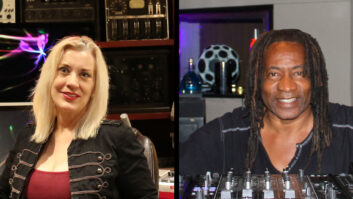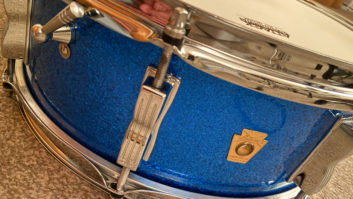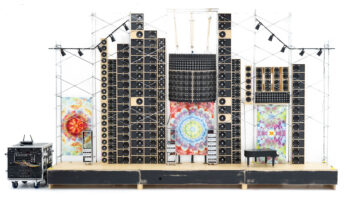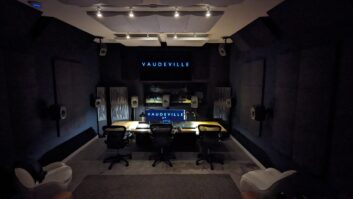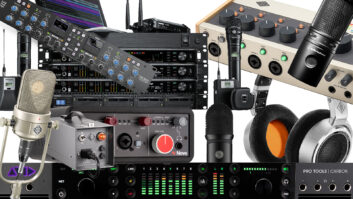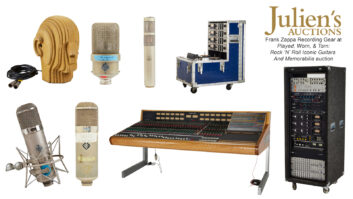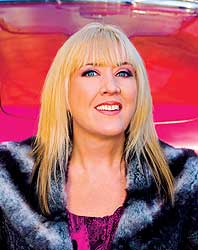
What the heck? Were those drums sat on by an elephant? Someone must have left that kick drum out in the rain, causing it to warp into a weird melted shape—like the cake in that old “MacArthur Park” song.
Long ago, while visiting Pro Drum Shop on Vine Street in Hollywood, a magnificent and unusual old set of drums caught my eye. The drums were so cool looking I didn’t even care what they sounded like. I had to know more about them. I had to have my own Trixon kit. Not just any Trixon kit, but the largest, most elaborate kit the company made.

My Trixon Speedfire kit took years to restore.
So my search began. I learned that Bill Haley & The Comets exclusively used Trixon drums in the 1950s as they witnessed the birth of rock ’n’ roll. Buddy Rich, Louie Bellson, Gene Krupa and Keith Moon played Trixons through the ’50s and ’60s. Ringo Starr played a Trixon kit with The Beatles during their Hamburg gigs before he got his legendary Ludwig endorsement. These German-made drums not only came in the wild melted Speedfire shape that was so intriguing to me, but also came in strange conical shapes and were made from curious, innovative materials long before other drum makers used them. Trixon also made more traditional cylindrical-style wood drums that were imported into the States until the ’70s.
Back East, I found a Trixon enthusiast who had a large Speedfire kit for sale that needed a complete restoration. We made a deal, I paid him in full and waited four freakin’ years for my kit to arrive. To add to my frustration, when it finally showed up it was incomplete. However, during those four long years, I never stopped looking for the elusive Trixons. It was an obsession. And one day I found a treasure trove of Trixon kits and parts in—of all places—Tucson, Ariz.

Bill Haley and drummer Dave Holly from the Comets goofing off for the 1964 Trixon catalog
In a darkened back room on the third floor of an ancient music shop called The Chicago Store (in downtown Tucson), I hit paydirt. I found stacks of conical and regular Trixons and two beautiful but disheveled Speedfire kits. You can imagine how my heart jumped out of my chest as the flashlight landed on those Speedfire sets, tucked away on a high shelf, untouched for at least a dozen years. I brought down the most complete kit but left the other behind for some other lucky person to find. Parts from that Chicago Store discovery were essential in completing my glorious Trixon Speedfire kit.

The treasure left behind at The Chicago Store
BIZARRE AND UNCONVENTIONAL
Reminiscent of a Salvador Dali sculpture, the drums are bizarre and unconventional works of art, yet their unusual shapes serve a purpose. The egg-shaped kick drum on the Speedfire model has a partition down the center of it (behind the drum head). The kick is played with two pedals, and each partitioned chamber has a different tone. The two kick drum tones can be played individually or with two feet, making the Speedfire way ahead of its time—the first double-kick drum design I know of.

A smiling Jim Keltner will try anything, at least once!
My Speedfire also has a Jetsons-style array of toms connected to the top of the kick drum. The toms are mounted opposite from a typical right-handed kit, with the smaller sizes running from right to left. This was done for a specific reason: Drummers who use their right foot as the dominant foot will want the larger, deeper chamber of the egg-shaped kick to be on the right side, making it necessary to mount the toms backward to accommodate the lopsided shape of the kick!
At the original factory in Hamburg, Germany, in the ’50s and ’60s, Karl-Heinz Weimer of Trixon made several unusual drum designs, including the early Telstar conical drums that used sound compression to create tone and power; the Jet Series in 1968 pioneered the use of Fiberglas shells; and Trixon’s most recognizable Speedfire design. And for a brief period in the ’60s, Trixon also imported drums into the States under the Vox name brand.
Later, Trixon was absorbed into Sonor Drums. The partners in the original Trixon company attempted to revive the brand in the late ’90s but an unfortunate factory fire destroyed the original molds for the signature shapes that made Trixon drums so special. There is hope that a new Trixon company, recently organized in 2007, will pick up the banner of innovation where Weimer left off. The new Trixon maker is currently in production, building traditional-style drum kits, beautiful cocktail sets and marching band drums.
Okay, so after all of this, what does it sound like? I brought my kit down to a session at The Village Recorder in West L.A., where legendary drummer Jim Keltner (Steely Dan, John Lennon, Eric Clapton) was cutting tracks; it was a delight to have him play the Speedfire on a song. The Trixon’s array of concert toms are built like bongos and their custom calfskin heads gave them a ping that’s very different than modern toms. Using a pair of Neumann U87s on the overheads to record the kit and direct-miking the front of the kick with a Neumann FET U47, the drums sang with a delicious warm and resonant vintage character.
If you’re interested in learning more about Trixon drums, there are excellent reference books written by Ingo Winterberg available at www.trixondrums.de. Also, Pro Drum Shop in Hollywood does a top-notch job of making custom calfskin heads, so don’t be afraid to purchase an original Trixon drum kit—they are a work of art and historic innovation!
Sylvia Massy is the unconventional producer and engineer of artists including Tool, System of a Down, Johnny Cash, Red Hot Chili Peppers, Tom Petty and Prince. She is a member of the NARAS P&E Wing Steering Committee and Advisory Boards, and is a resident producer at RadioStar Studios in Weed, Calif.

